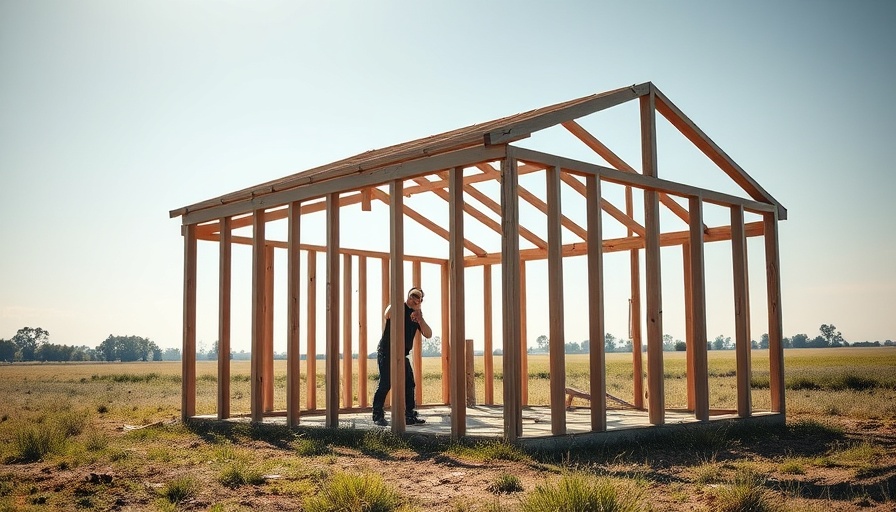
Are You Really Ready to Build a Storage Shed?
Building a storage shed can be an exciting project for homeowners eager to expand their space and organize tools and equipment. However, many DIY enthusiasts find themselves in a tangle of miscalculations and structural issues that could have easily been avoided. With the right knowledge and planning, you can navigate these common pitfalls and ensure your shed turns out just as you envisioned. This guide will help highlight the most critical mistakes and how to avoid them.
In '5 Storage Shed Building Mistakes Most People Make', the discussion dives into common pitfalls in DIY shed construction, exploring key insights that sparked deeper analysis on our end.
Foundation First: The Key to a Solid Shed
The first common error many homeowners make is neglecting the shed's foundation. It’s easy to get caught up in the excitement of building; however, starting off on the incorrect footing can lead to disastrous results. Scott from Everyday Home Repairs emphasizes that taking the time to create a level foundation is crucial. Whether you opt for a concrete pad, concrete blocks, or gravel, ensuring its levelness will save you time and frustration as you construct subsequent walls.
A solid foundation supports the entire structure’s integrity, so investing in this stage pays off in the long run. Have a laser level handy to ensure everything’s on point before moving forward!
Precision Matters: Measuring Right Can Save Your Build
Once your foundation is down, it's time to frame the walls. This is where precision becomes paramount. As Scott rightly points out, one common misconception is that all boards labeled with a specific length, like 16 feet, are that exact dimension. In practice, material shrinkage and variances are common, which can throw off your wall's measurements significantly. Always check your dimensions against your plans to ensure everything aligns accurately before cutting.
Additionally, be mindful of how different parts of the wall assembly, like top and bottom plates, may affect total wall height. Getting these right prevents headaches later on.
Making a Plan: Visualize the Structure
Another pivotal aspect is having a clear plan for your build. Common mistake number three revolves around strategic planning in getting your walls up and understanding the functionality of each wall’s role in the shed’s structure. For instance, Scott mentions the importance of knowing when to call for reinforcement, especially with heavy walls that could easily be a safety hazard.
Creating a visual schema or checklist helps you stay organized, which ensures each aspect of the wall is completed with safety and effectiveness in mind—especially when it comes to framing windows or doors that add complexity to your project.
The Right Tools: Enhancing Your Workflow
In the world of DIY, your tools often dictate the project's success. Scott's video underscores how using screws rather than only nails for securing framing can offer flexibility for adjustments. Unlike nails, screws allow for easy disassembly if you need to adjust your alignment. Also, having the right anchors, jacks, and clamps makes a significant difference when you’re alone in the building process.
Investing in suitable tools not only makes the build easier but also enhances your end product’s quality. It can be helpful to gather tools ahead of time to streamline the construction process.
A Community of Builders: Join the Movement
If you’re inspired to take your DIY skills to the next level, consider joining a community of builders. Resources like the upcoming shed-building course from Scott offer structured guidance and mentorship. Pooling knowledge and experience with other DIY enthusiasts can accelerate learning curves and foster new skills that might otherwise take years to hone alone.
By tapping into a community, you gain insights from others’ experiences—both their successes and mistakes. This collaborative approach ensures you aren’t just building sheds but building confidence in your ability to tackle larger projects.
Conclusion: Your DIY Journey Begins Here
In summary, take the time to assure a solid foundation, make precise measurements, devise a clear plan, gather the necessary tools, and consider engaging with a community. By avoiding these common mistakes, you significantly increase your chances of a successful shed-building project. So gather your materials and get ready to bring your vision to life!
Explore more DIY resources and take your skills to new heights—it's time for you to create the storage solution you’ve been dreaming about!
 Add Row
Add Row  Add
Add 




Write A Comment